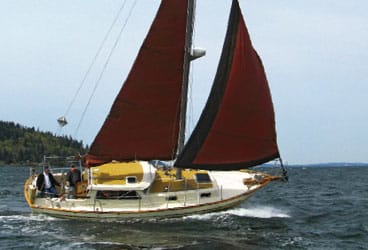
RawsonPH30
Ron Rawson built some of the U.S. West Coast’s finest workboats—tough and able gillnetters, long-liners, and others that ply the waters between California and the Gulf of Alaska. When he decided to build sailboats, he wanted to continue the firm’s reputation for building seaworthy small craft and commissioned Pacific Northwest naval architect William Garden to design the Rawson 30. Between 1959 and 1985, he built 288 Rawson 30s, of which 36 were pilothouse models.
Bluff-bowed and rugged, with a long keel encapsulating 5,000 pounds of boiler punchings and concrete, the Rawson 30 was intended strictly for cruising. The hull is hand-laid solid fiberglass, while the deck is of fiberglass and balsa sandwich construction. Its bulwarks, 6 inches high at the bow, are fit for wedging in seaboots whether you’re hauling in salmon or changing headsails when thrashing to windward, and its cockpit is small, as befits a bluewater boat, while still adequate for two. Hardware is robust and simple.
Rawson added the Pilothouse model out of respect for Pacific Northwest weather. An enclosed wheelhouse is a great boon because passagemaking through these island-studded waters, with their narrow channels and swift currents, entails a lot of motoring.
The wheel and navigation instruments are located to starboard under the sloping windshield. There’s a useful table and considerable storage aft of the helmsman’s seat. To port, a comfortable dining table converts to a double berth with storage beneath.
Two steps down, to starboard, is a small in-line galley with sink, icebox, and stove. To port, a 6-foot-6-inch berth tucked under the pilothouse and a diesel heater just forward of it form a sort of inglenook—a cozy space on chilly winter cruises. The full bow provides space for a 6-foot-6-inch double berth with plenty of shoulder room. The small head contains a sink, shower, and storage.
The PH 30 is a masthead sloop with a single-spreader, deck-stepped aluminum mast supported by double lower and single upper shrouds, headstay, and backstay. A compression post is stoutly integrated into the bulkhead below. The mainsheet traveler sits atop the after end of the pilothouse. Early boats had a little too much weather helm; a stocky bowsprit was added to address it.
| LOA | 30’ 6” |
| LWL | 22’ 0” |
| Beam | 9’ 0” |
| Draft | 5’ 0” |
| Sail Area (100%) | 424 sq. ft. |
| Ballast | 5,000 lb. |
| Displacement | 12,000 lb. |
| Ballast/D | .42 |
| D/L | 503 |
| SA/D | 12.9 |
| Water | 45 gal. |
| Fuel | 37 gal. |
| Engine | Various |
| Designer | William Garden |
Rawsons have been powered by a variety of engines. When the dining table is removed, sliding hatches in the pilothouse sole provide good access to the engine and to other mechanical and electrical equipment.
It takes a little breeze to get the PH 30 going, but at 20 to 25 knots, it’s time to put in a reef and roll in a bit of genoa. In these winds the boat at first feels a little tender, but once settled down, its motion is steady. The boat tracks well and rarely takes any water over the bow or into the cockpit. In higher winds, the heeling effect makes steering from the inside helm station difficult on port tack. The pilothouse is at its best in quieter seas, on long treks, and at anchor.
It’s difficult to fault the Rawson PH 30 within its limitations. It’s slow and not very close-winded when compared with contemporary 30-foot racer/cruisers, and the pilothouse’s weight and windage make it a little tender. The side decks, to favor the accommodations, are a tad narrow, but altogether, the boat meets the requirements of all-weather cruising in the Pacific Northwest. The solid and commodious Rawson PH 30 will provide safe and exciting year-round voyaging for decades to come.
Architect Richard Smith and his wife, Beth, sail their Ericson Cruising 31, Kuma, on the waters of the Pacific Northwest.








